The Microsoft Surface Pro (2017) Review: Evolution
by Brett Howse on June 15, 2017 9:00 AM ESTGraphics Performance
With the Core i7-7660U, we finally get a chance to look at the Intel Iris Plus Graphics 640 in a notebook. On a typical U series Intel Core processor, there are 24 execution units (EUs) available, but the Iris Plus doubles that to 48. Despite having the same TDP, having twice as many EUs running should still be a big boost to performance, as even if they need to throttle, there are twice as many, so they can run slow and wide and still fit in the TDP. The base frequency for the graphics is 300 MHz, with a 1.1 GHz boost frequency.
The addition of 64 MB of eDRAM is also a large benefit to graphics, which needs a lot more memory bandwidth than the CPU, and having this extra eDRAM as a cache for the GPU is a big benefit to the Iris Plus graphics.
In the graphs below, make note that the Dell XPS 15 has a GTX 960M graphics card, which should win pretty handily, but the Surface Book has a smaller GT 940M with 2 GB of GDDR5, so it will be interesting to see the performance difference between the integrated Iris Plus Graphics 640, and a discrete entry-level GPU.
3DMark
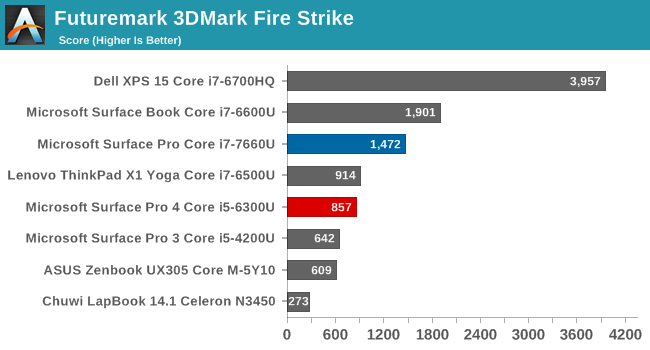
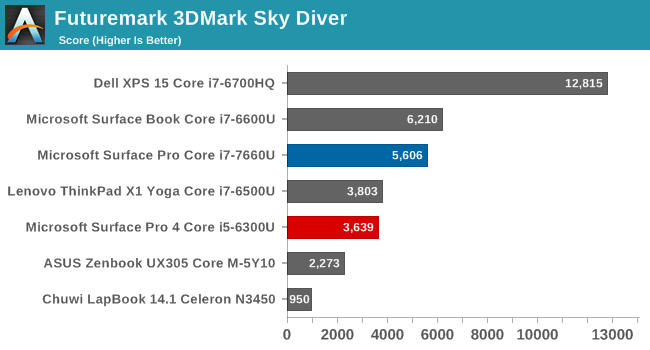


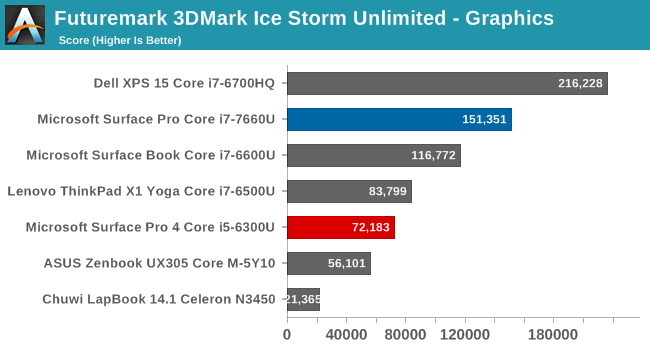
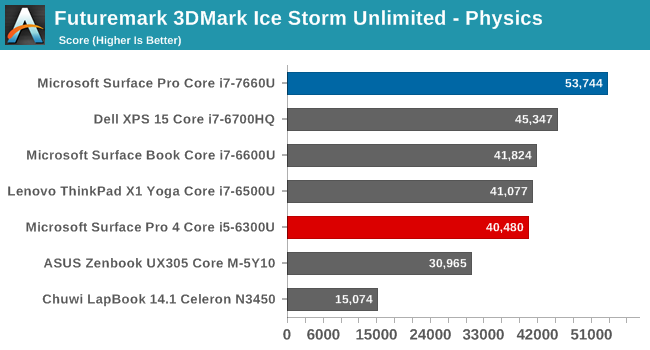
Futuremark’s 3DMark continues to be developed, and new tests have been added for higher end systems, but for our purposes on this review, the normal results will do just fine. Each of the tests move from quality to performance, with Fire Strike being the most demanding, and Ice Storm Unlimited being a smartphone or tablet test. The GT 940M in the Surface Book still manages to hold an edge on the more graphically demanding tests, but is then surpassed as the workload gets easier, and the test becomes more CPU bound. Compared to the non-Iris Ultrabooks though, the i7-7660U delivers a lot more performance.
GFXBench
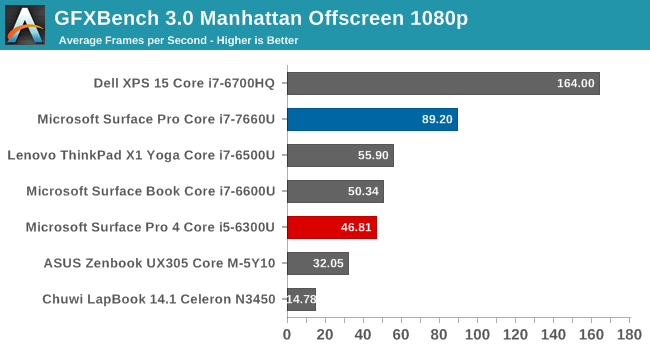

Another synthetic, Kishonti’s GFXBench also continues to evolve, with new tests being added to provide more stressful tests than the older T-Rex and Manhattan ones. Since we don’t have any comparison data, for now we’ll stick with the older tests while we fill out the data gaps. The Intel Iris graphics pull out a hefty lead here.
Dota 2
Valve’s Dota 2 online area game continues to be our go-to game for testing systems with lower end graphics, since it has a low barrier of entry, and is quite playable at low settings even on a system with integrated graphics.
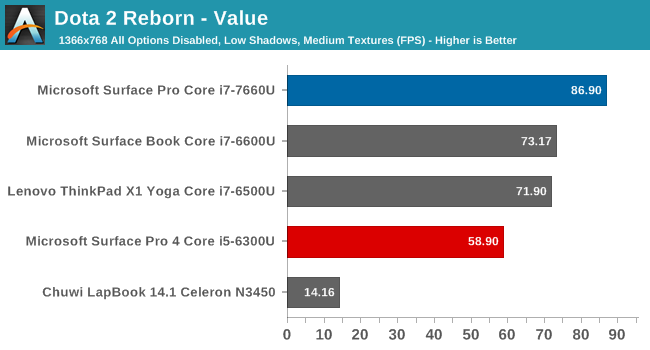
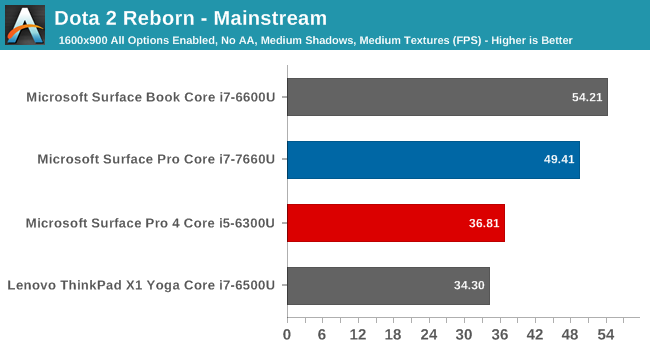
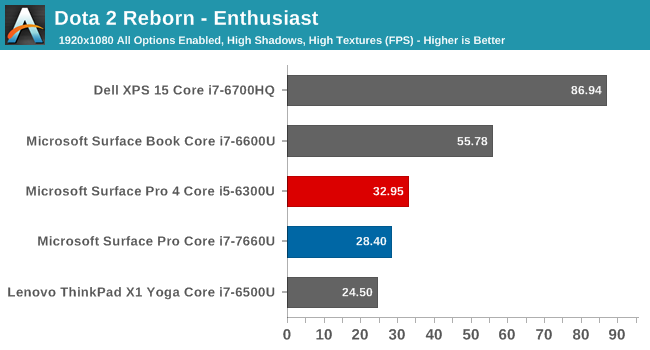
Here the Iris Plus Graphics do not bring the kind of improvement that would have been hoped for. At lower settings, they are very capable, and the extra CPU speed from the i7-7660U helps break the CPU bound barrier of the other systems, but once the graphics are turned up, the U series chip runs into the thermal barrier of only having a 15-Watt TDP. Compared to the Microsoft Surface Book, with it’s discrete GT 940M GPU, there’s really no contest, since that GPU alone would have 20-30 Watts of TDP available to it. The Iris does allow a lot more graphics potential, but for longer duration requirements, it may not offer much of an upgrade.
Graphics Conclusion
It’s great to finally be able to test a system with a U Series CPU and Iris graphics, and the results are quite impressive. It’s not quite up to par with even a low-end discrete GPU, but compared to the other integrated GPUs available in the other Ultrabooks, the Iris really brings the performance up a step. For light gaming, it should work well, but the extra eDRAM can help out on practically any task. The extra EUs available would also be of benefit to any productivity app that can leverage the GPU for some of its compute.
Storage Performance
PCIe SSDs have been the name of the game for the last couple of generations of Ultrabooks, but they’ve generally been shipping in the M.2 form factor. Microsoft has gone a different route with the new Surface Pro, by moving to a much smaller BGA SSD in the Samsung PM971.
The benefits of going this route are mostly packaging. The BGA SSD is significantly smaller than any M.2 SSD, especially the 2280 versions that are the most common. The drive is also most likely more energy efficient than the fastest SSDs available today, which should help with battery life.
There is likely only one downside to the PM971 BGA SSD, and that is performance. While still much faster than a SATA SSD, the PM971 is limited to a PCIe 3.0 x2 link, which is going to impact the maximum read and write speeds.
As you can see in the CrystalDiskMark test, the maximum read speed is well under something like a Samsung SM961. This may seem like bad news, but in fact the PM971 actually outperforms the same size PM951 drive which was easily the most popular SSD found in Ultrabooks until recently. The PM971 is 48 layer TLC NAND, with reasonable write speeds, and other than the lowered maximums created by the PCIe link being x2 instead of x4, the performance is quite good.
When you look at a device like the Surface Pro, where space is at a premium, these are the kinds of compromises that make sense when you consider that they’ve increased the battery capacity by 15%, and despite going with a compact SSD, they’ve still increased performance over the outgoing model assuming it had a PM951, which it seemed most did.


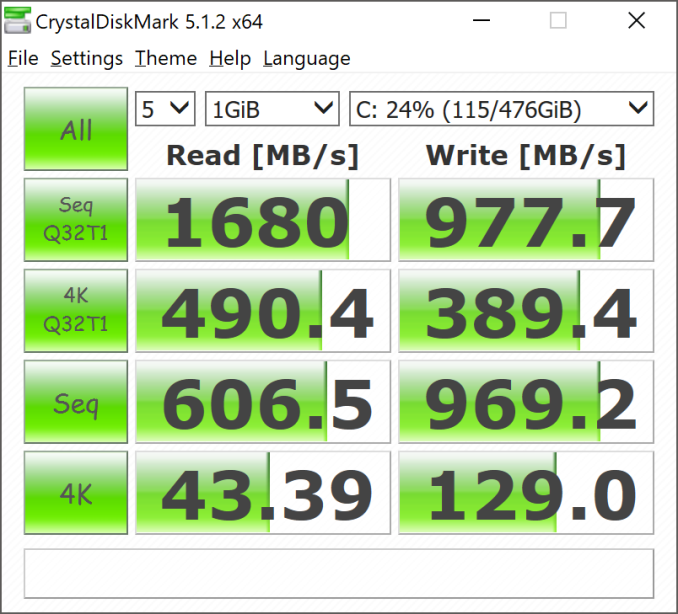








124 Comments
View All Comments
beggerking@yahoo.com - Monday, July 10, 2017 - link
Liar! how much is Crapple paying you?they never even made a sp3 with w7... in fact... my surface pro 1 came with windows 8...
Laxaa - Friday, June 16, 2017 - link
Brett, do you think it's worth upgrading from the SP4 for heavy usage (Adobe, SolidWorks) or should I get the Surface Book instead? I have the i5 w/8GB RAM and it's getting kind of limiting. At least when it comes to memory (SolidWorks keeps bugging me with low RAM warnings all the time)Or perhaps the XPS 15 would be a better choice?
Brett Howse - Friday, June 16, 2017 - link
Upgrading from SP4 to SP isn't something I would recommend to everyone, but you're in a situation where you needed a faster SP4 anyway. There's a big jump (as I'm sure you saw) from the i5 SP4 to this i7 model. Obviously the XPS 15 is much bigger, and has way more GPU, but you lose the portability.As much as this is an incremental upgrade over the 4, it's a lot of very nice small changes.
I can't recommend the Surface Book right now only because it's really in need of a refresh - especially the GPU - but I do like the Book very much if you need more performance and battery life. I'd hold off though and see after it gets an update.
Laxaa - Sunday, June 18, 2017 - link
I'll probably wait for a Book-refresh before I make a decision. The dGPU would probably be nice to have, and hopefully they can cram a Pascal-series GPU into the base.jrs77 - Friday, June 16, 2017 - link
If it wasn't for the spysoftware named Windows 10 I'd probably would get an i5-based Surface Pro.yhselp - Friday, June 16, 2017 - link
1.4 GHz on the CPU and 750 MHz on the GPU for sustained loads - expected, normal, but still somehow disappointing. You're essentially getting a very low-clocked dual-core CPU paired with about 580 GFLOPS of GPU with up to 100 GB/s memory bandwidth, if my amateur calculations are not entirely idiotic. Of course, said CPU having hyper-threading, AVX, L4 cache, and the latest Intel microarchitecture, certainly helps.I wonder what the m3-7Y30 in the entry model is capable of under a sustain load. I'd suspect about 550 MHz on the CPU and about 240 GFLOPS for the GPU.
BrokenCrayons - Friday, June 16, 2017 - link
Wikipedia has some information regarding the performance of the GPUs in question here:https://en.wikipedia.org/wiki/Intel_HD_and_Iris_Gr...
To summarize quickly, the 615 is rated at 345.6 - 403.2 GFLOPS and the 640 is capable of 729.6 - 806.4 GFLOPS, but that excludes variables specific to the Surface Pro in question.
Eliadbu - Friday, June 16, 2017 - link
Those absurd prices and base specs are so bad and the lack of ports. Also the fact that the keyboard and pen are purchased separately, it feels like Microsoft are going with their heads against the wall. Better wait for Eve-V value and the thinking of what the user needs are so ahead.zeeBomb - Friday, June 16, 2017 - link
Awesome write-up!ZipSpeed - Friday, June 16, 2017 - link
I bought a Surface Pro 4 last year thinking it could replace my iPad Gen 4 and 2010 Macbook Air in one fell swoop. Needless to say, I couldn't get use to the size of the device in tablet mode, and it wasn't very steady on my lap when I used the kickstand & type cover. I decided to return it, and even now, I'm still using my old (and slow) iPad and MBA as I continue my search.